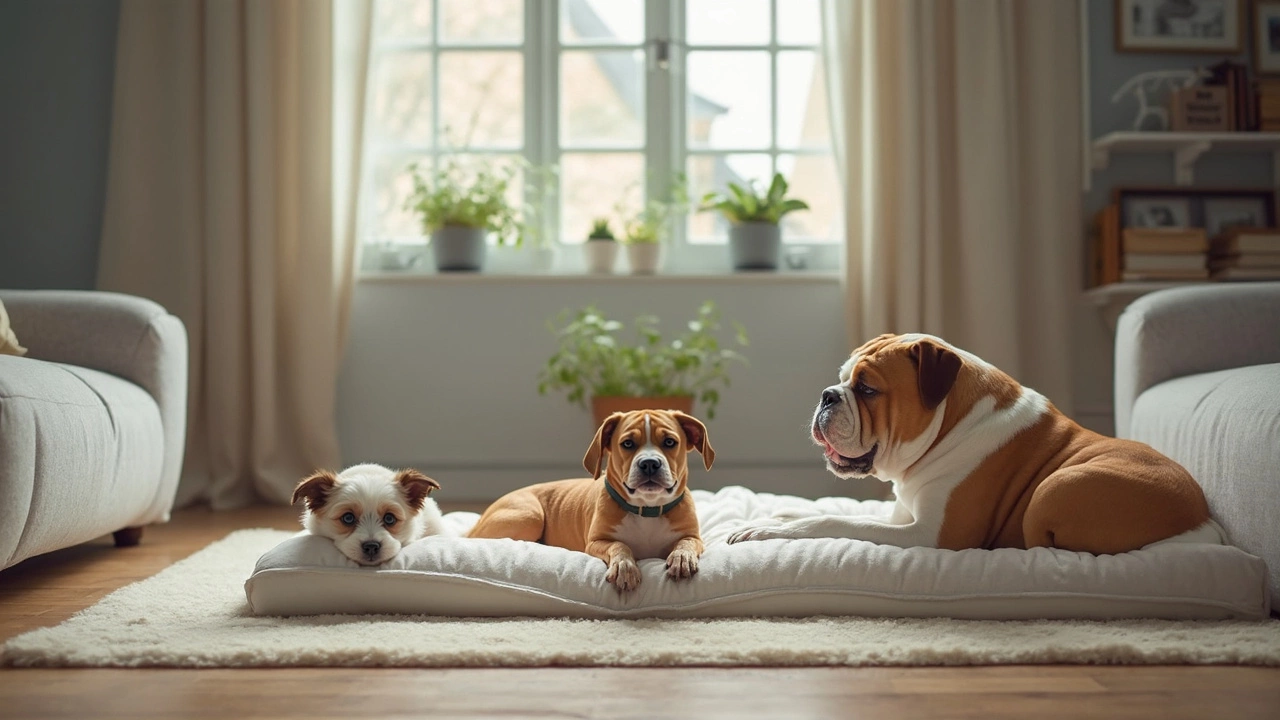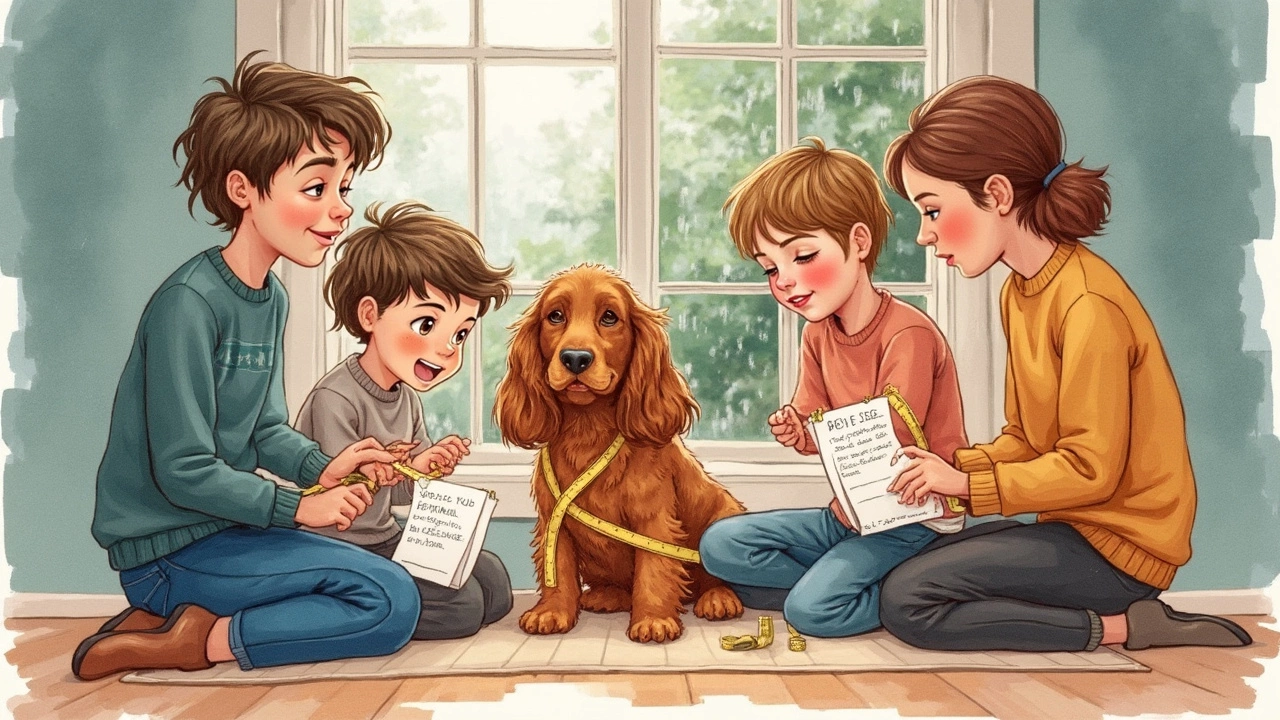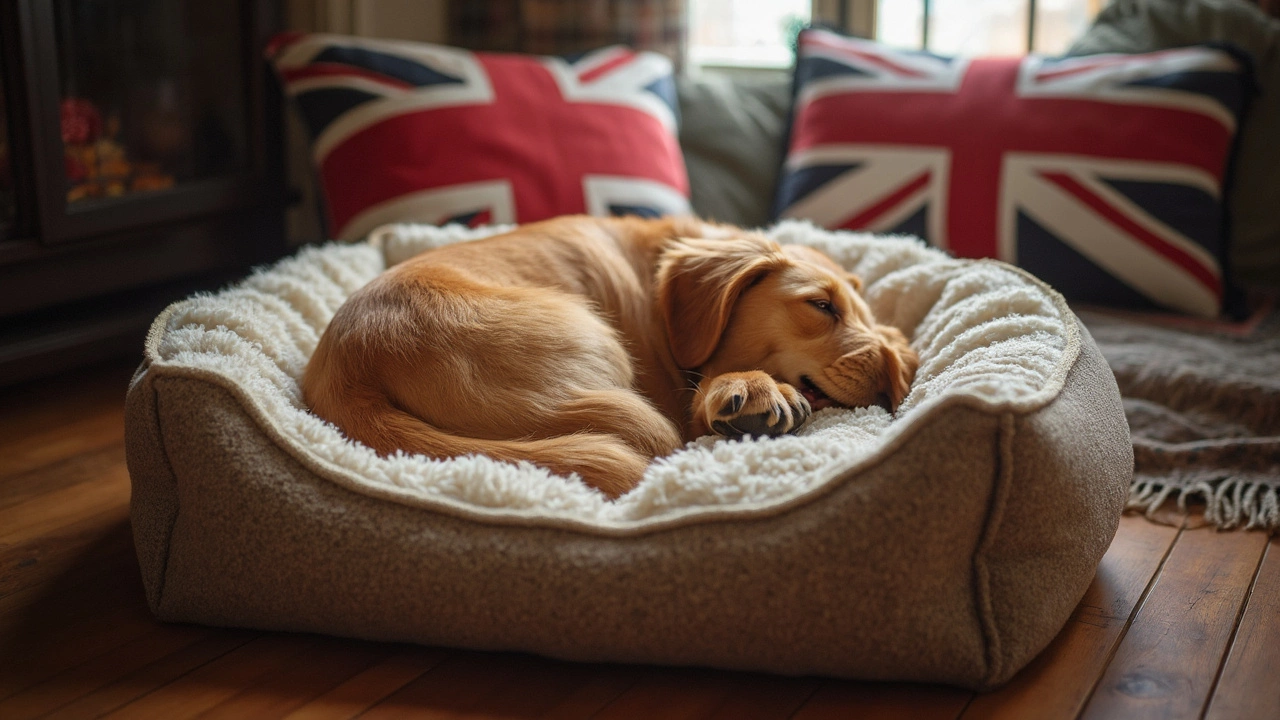If you’re wondering if your dog's bed should be bigger than your dog, you’re not alone. Sizing a dog bed isn’t just guesswork—your dog's comfort depends on it. Dogs use their beds for napping, stretching, and sometimes a bit of dramatic flopping. If the bed’s too small, your pup might end up half on the floor, or twist into awkward shapes that aren't good for their joints.
Measuring your dog is the first step. For most breeds, add at least 6 to 12 inches to their length when lying down. That extra space lets them stretch out, turn around, or curl up without running out of room. If you have a toy breed that loves to snuggle into tight corners, a smaller bed might actually feel safer for them. But for sprawlers and larger breeds, extra space can mean less stiffness and better sleep.
Most people make the mistake of eyeballing bed size in the store, picking what looks cute or fits in a corner. But comfort always beats looks here. Your dog's joints, age, and personality matters much more than your home decor.
- Why Bed Size Matters for Dogs
- How to Measure Your Dog for a Bed
- Sleeping Styles and Space Needs
- Common Sizing Mistakes
- Tips for Picking the Perfect Bed
Why Bed Size Matters for Dogs
A dog bed size isn’t just about how cozy it looks; it can actually affect your dog’s health. If a bed is too small, dogs can’t stretch out, which puts awkward pressure on their joints and hips. Over time, this can make things like arthritis even worse—especially for older pups and larger breeds that are already prone to joint trouble.
On the flip side, a bed that’s way too big can feel chilly or insecure, especially for smaller dogs who naturally look for snug, den-like spaces. But comfort usually comes first, and most dogs love having room to move around. According to a 2023 survey by the American Pet Products Association, dogs with beds that allow for full-body stretching are up to 40% more likely to show signs of restful sleep, like deep breathing and relaxed paws.
Here’s what gets affected when you pick the wrong-sized bed:
- Dog beds that are too small can cause stiffness in the morning after a night of cramping up.
- Beds that don’t fit your dog’s style—like the curlers vs. the sprawlers—leave them restless and flopping off the edge.
- Too-small beds wear out quicker because dogs end up sleeping half-off, putting extra strain in just one area.
- Stress levels actually rise if dogs can’t find a comfy space, especially with puppies or anxious rescue dogs.
If your dog avoids the bed and goes for your couch or the cool tile, that’s usually a sign that the size isn’t right. The bottom line? Picking the right dog bed size is about keeping your pup happy, rested, and ready for zoomies—because a well-rested dog is a happier dog all around.
How to Measure Your Dog for a Bed
Getting the size right is a game-changer for your pup’s comfort. To pick the perfect dog bed size, you need more than a rough guess—grabbing a tape measure is the way to go. If you skip this step, you might end up with a bed that’s a little too tight or way bigger than needed.
- Ask your dog to lie down flat, either stretched out on their side or in their favorite sleeping position.
- Measure from the tip of their nose to the base of their tail. This gives you their true length when relaxed.
- Then, measure from one shoulder, over their back, to the other side, to get the width.
- Add 6-12 inches to both numbers for wiggle room. This extra space lets your dog shift around and stretch. Larger breeds or dogs that sprawl might appreciate even more space, while curlers can get by with less.
If you're not sure, double-check the weight recommendations on the dog beds you’re looking at, but know that length and width measurements matter much more—weight limits mostly help with bed durability, not comfort.
| Dog Size | Dog Length | Recommended Bed Length |
|---|---|---|
| Small (e.g., Pug, Dachshund) | 18"-24" | 24"-36" |
| Medium (e.g., Border Collie, Bulldog) | 25"-36" | 36"-48" |
| Large (e.g., Labrador, Golden Retriever) | 37"-45" | 48"-54" |
| Giant (e.g., Great Dane, Mastiff) | 46"+ | 54"-60" |
Keep in mind, beds with raised sides or bolsters take away from the flat space, so look for the inside dimensions (sleeping area), not just the total bed size. If your dog likes to hang a paw or head off the edge, don’t stress too much about a few extra inches—go with what fits your living space and dog’s habits.

Sleeping Styles and Space Needs
Not every pup sleeps the same way, and that’s a big deal when picking the right dog bed size. Some dogs curl tight in a ball, others sprawl out like they own the whole living room. It matters because those habits shape how much space they need for good, comfy sleep.
Let’s break down a few common dog sleeping styles:
- The Curler: These dogs tuck in their legs and make themselves tiny. Dachshunds, Chihuahuas, or dogs in colder homes often do this. They need a bed that feels snug, but still has at least a few inches of extra room in case they stretch out.
- The Sprawler: Think Labs, Goldens, or any dog that loves to really stretch out. These pups often need a dog bed that's much bigger than their body length so they’re not awkwardly hanging off.
- The Belly Flopper: Some dogs rest flat with their legs splayed out like superhero capes. They need belly space plus extra inches for their feet and tail.
- The Leaner or Snuggler: Dogs who love to press against bolsters or sides, like Greyhounds or anxious pups, usually look for a bed with raised edges and enough space to change positions easily.
If you’re not sure how much room your dog actually uses, snap a pic of them sleeping. Use that as a guide. Remember, younger or athletic dogs often switch up positions more than older dogs, and they’ll need the extra space to move around at night.
| Sleeping Style | Recommended Extra Bed Space |
|---|---|
| Curler | +4-6 inches |
| Sprawler | +8-12 inches |
| Belly Flopper | +10 inches (width) |
| Leaner/Snuggler | Room for bolsters, +6 inches |
If you have more than one dog and they like to pile up, make sure the dog bed is big enough for both with their comfy quirks added in. When in doubt, go a bit bigger—dogs usually don't mind a little extra wiggle room.
Common Sizing Mistakes
Picking the right dog bed size sounds easy, but a lot of people get it wrong—and their pups end up not loving their new spot. Here are the most common mistakes people make when shopping for dog beds:
- Guessing instead of measuring: If you skip getting out the tape measure, chances are you’ll misjudge. Always measure your dog from nose to base of tail while they’re lying down, then add a bit extra for stretching room.
- Thinking small is snuggly for every breed: While some pups love a cozy, tight spot, bigger dogs or those with joint issues need more space. A cramped dog bed can actually make joint stiffness worse, especially for senior dogs.
- Focusing only on looks: A cute bed that matches your rug doesn’t matter if it’s not comfortable or sized right. Function beats style every time.
- Forgetting changing needs: Puppies grow—fast. If you buy a tiny bed, you’ll be shopping again in a couple months. For adult dogs, weight and health changes also matter, so sometimes upgrading bed size makes sense.
- Assuming all beds are sized the same: There’s no standard for dog bed sizing. A “large” bed in one brand could be a medium in another. Always check measurements instead of trusting size labels.
Here’s a quick look at real bed sizes versus the weight limits some brands use:
| Bed Size (inches) | Suits Dogs Up To (lbs) |
|---|---|
| 24" x 18" | Under 25 lbs |
| 30" x 20" | Up to 40 lbs |
| 36" x 23" | Up to 70 lbs |
| 42" x 28" | Up to 90 lbs |
Don’t rely on weight alone, though—length and your pup's favorite sleep pose matter more. A larger dog that curls up tight might be happy in a medium bed, while a long-legged sprawler really needs those extra inches. When in doubt, size up just a bit. Your dog will thank you.

Tips for Picking the Perfect Bed
Choosing the right dog bed size and style can be pretty simple when you know what to look for. Start by watching how your dog likes to sleep—curled up, stretched out, or resting with their head propped up. This matters way more than the bed’s color or price tag.
Here are a few straightforward tips you can count on:
- Measure your dog from nose to tail while they’re lying in their natural sleeping pose. Add six to twelve inches extra for a comfortable fit. This will help you find the sweet spot—not too small, not too massive.
- Consider your dog’s age and health. Older dogs or those with joint issues often do best with orthopedic beds that provide extra support. Puppies need something washable since accidents happen.
- Think about materials. Tough chewers need more durable fabrics. Dogs with allergies may need hypoallergenic or natural fiber beds. Easy-to-wash covers save you headaches down the line.
- Location matters. If the bed goes in a drafty spot, look for one with raised sides or bolsters to help your pup feel secure and cozy.
- Compare brands and reviews. Not all beds labeled "large" or "small" are sized the same. Check sizing charts and real customer feedback for the most accurate fit.
Ever wonder what bed type dogs prefer? A recent survey of 2,000 U.S. dog owners found that 63% of dogs chose beds with bolsters or raised edges, and 80% owners noticed better sleep quality when the bed fit their dog well. Here’s a quick look at popular dog bed styles and what dogs they tend to suit:
| Bed Style | Best For |
|---|---|
| Bolster Bed | Dogs who like head support, feeling secure |
| Flat Mattress | Large breeds, sprawlers |
| Donut/Cuddler | Small breeds, dogs who curl up |
| Orthopedic | Seniors or dogs with joint issues |
A dog bed isn’t a splurge—it’s a daily comfort item your pup counts on. Take your time, measure twice, and always put your dog’s comfort and health at the top of your list when choosing the dog bed size.
